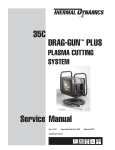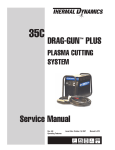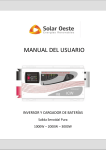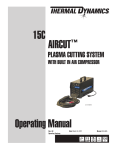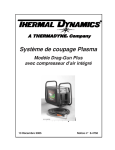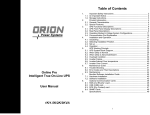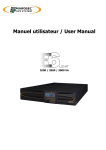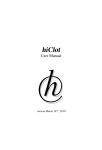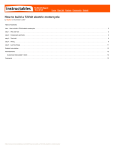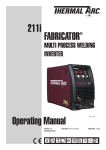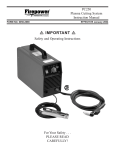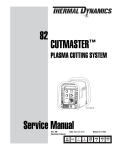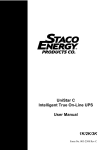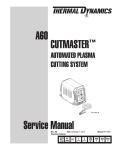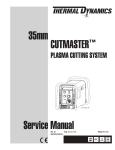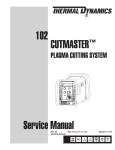Download FIREPOWER® FP-35A - Victor Technologies
Transcript
FP-35A FIREPOWER ® PLASMA CUTTING SYSTEM Art # A-04502 Service Manual Version No: 1 Issue Date: November 8, 2005 Operating Features: PLASMA Manual 0-4695 TABLE OF CONTENTS (continued) SECTION 1: GENERAL INFORMATION ................................................................................................ 1-1 1.01 1.02 1.03 1.04 1.05 Notes, Cautions and Warnings ...................................................................... Important Safety Precautions ....................................................................... Publications .................................................................................................. Declaration of Conformity ............................................................................. Statement of Warranty .................................................................................. 1-1 1-1 1-3 1-4 1-5 SECTION 2: INTRODUCTION ............................................................................................................... 2-1 2.01 2.02 2.03 2.04 2.05 Overview ...................................................................................................... General Specifications .................................................................................. Torch Specifications ..................................................................................... System Contents .......................................................................................... Transporting Methods ................................................................................... 2-1 2-1 2-2 2-2 2-2 SECTION 3: INSTALLATION .................................................................................................................. 3-1 3.01 Site Selection ............................................................................................... 3-1 3.02 Electrical Input Connections ......................................................................... 3-1 3.03 Compressed Air Connection ......................................................................... 3-1 SECTION 4: OPERATION ...................................................................................................................... 4-1 4.01 Front Control Panel ....................................................................................... 4-1 4.02 Preparations For Operating ........................................................................... 4-2 SECTION 5: MAINTENANCE .................................................................................................... 5-1 5.01 General Maintenance .................................................................................... 5-1 5.02 Maintenance - Torch O-Rings ........................................................................ 5-2 SECTION 6: TROUBLESHOOTING ....................................................................................................... 6-1 6.01 6.02 6.03 6.04 6.05 6.06 Setup and Operation .................................................................................... Basic Trouble Shooting Guide ....................................................................... Control PCB Indicators ................................................................................. Open Circuit Voltage Check .......................................................................... Detailed Fault Finding / Error Indicators ........................................................ Torch Tests ................................................................................................... 6-1 6-2 6-3 6-4 6-4 6-8 SECTION 7: PARTS LIST ...................................................................................................................... 7-1 Appendix 1: Operating Sequence, Block Diagram ..................................................................... A-1 Appendix 2: Torch Connection ................................................................................................... A-2 Appendix 3: Microchip Pin-Out .................................................................................................. A-3 Appendix 4: System Schematic ................................................................................................ A-4 To prevent possible injury, read, understand and follow all warnings, safety precautions and instructions before using the equipment. Call 1-603-298-5711 or your local distributor if you have any questions. SECTION 1: GENERAL INFORMATION 1.01 Notes, Cautions and Warnings Throughout this manual, notes, cautions, and warnings are used to highlight important information. These highlights are categorized as follows: NOTE An operation, procedure, or background information which requires additional emphasis or is helpful in efficient operation of the system. GASES AND FUMES Gases and fumes produced during the plasma cutting process can be dangerous and hazardous to your health. • Keep all fumes and gases from the breathing area. Keep your head out of the welding fume plume. • Use an air-supplied respirator if ventilation is not adequate to remove all fumes and gases. CAUTION • The kinds of fumes and gases from the plasma arc depend on the kind of metal being used, coatings on the metal, and the different processes. You must be very careful when cutting or welding any metals which may contain one or more of the following: A procedure which, if not properly followed, may cause damage to the equipment. WARNING Antimony Arsenic Barium Beryllium Cadmium A procedure which, if not properly followed, may cause injury to the operator or others in the operating area. Mercury Nickel Selenium Silver Vanadium • Always read the Material Safety Data Sheets (MSDS) that should be supplied with the material you are using. These MSDSs will give you the information regarding the kind and amount of fumes and gases that may be dangerous to your health. 1.02 Important Safety Precautions WARNINGS OPERATION AND MAINTENANCE OF PLASMA ARC EQUIPMENT CAN BE DANGEROUS AND HAZARDOUS TO YOUR HEALTH. • For information on how to test for fumes and gases in your workplace, refer to item 1 in Subsection 1.03, Publications in this manual. Plasma arc cutting produces intense electric and magnetic emissions that may interfere with the proper function of cardiac pacemakers, hearing aids, or other electronic health equipment. Persons who work near plasma arc cutting applications should consult their medical health professional and the manufacturer of the health equipment to determine whether a hazard exists. November 8, 2005 Chromium Cobalt Copper Lead Manganese • Use special equipment, such as water or down draft cutting tables, to capture fumes and gases. • Do not use the plasma torch in an area where combustible or explosive gases or materials are located. • Phosgene, a toxic gas, is generated from the vapors of chlorinated solvents and cleansers. Remove all sources of these vapors. 1-1 GENERAL INFORMATION • This product, when used for welding or cutting, produces fumes or gases which contain chemicals known to the State of California to cause birth defects and, in some cases, cancer. (California Health & Safety Code Sec. 25249.5 et seq.) cut aluminum alloys underwater or on a water table unless the hydrogen gas can be eliminated or dissipated. Trapped hydrogen gas that is ignited will cause an explosion. NOISE ELECTRIC SHOCK Electric Shock can injure or kill. The plasma arc process uses and produces high voltage electrical energy. This electric energy can cause severe or fatal shock to the operator or others in the workplace. Noise can cause permanent hearing loss. Plasma arc processes can cause noise levels to exceed safe limits. You must protect your ears from loud noise to prevent permanent loss of hearing. • To protect your hearing from loud noise, wear protective ear plugs and/or ear muffs. Protect others in the workplace. • Never touch any parts that are electrically “live” or “hot.” • Wear dry gloves and clothing. Insulate yourself from the work piece or other parts of the welding circuit. • Noise levels should be measured to be sure the decibels (sound) do not exceed safe levels. • For information on how to test for noise, see item 1 in Subsection 1.03, Publications, in this manual. • Repair or replace all worn or damaged parts. • Extra care must be taken when the workplace is moist or damp. • Install and maintain equipment according to NEC code, refer to item 9 in Subsection 1.03, Publications. • Disconnect power source before performing any service or repairs. • Read and follow all the instructions in the Operating Manual. PLASMA ARC RAYS Plasma Arc Rays can injure your eyes and burn your skin. The plasma arc process produces very bright ultra violet and infra red light. These arc rays will damage your eyes and burn your skin if you are not properly protected. • To protect your eyes, always wear a welding helmet or shield. Also always wear safety glasses with side shields, goggles or other protective eye wear. FIRE AND EXPLOSION • Wear welding gloves and suitable clothing to protect your skin from the arc rays and sparks. Fire and explosion can be caused by hot slag, sparks, or the plasma arc. • Keep helmet and safety glasses in good condition. Replace lenses when cracked, chipped or dirty. • Be sure there is no combustible or flammable material in the workplace. Any material that cannot be removed must be protected. • Protect others in the work area from the arc rays. Use protective booths, screens or shields. • Ventilate all flammable or explosive vapors from the workplace. • Do not cut or weld on containers that may have held combustibles. • Provide a fire watch when working in an area where fire hazards may exist. • Hydrogen gas may be formed and trapped under aluminum workpieces when they are cut underwater or while using a water table. DO NOT GENERAL INFORMATION 1-2 November 8, 2005 • Use the shade of lens as suggested in the following per ANSI/ASC Z49.1: Arc Current Minimum Protective Shade No. Suggested Shade No. Less Than 300* 8 9 300 - 400* 9 12 400 - 800* 10 14 * These values apply where the actual arc is clearly seen. Experience has shown that lighter filters may be used when the arc is hidden by the workpiece. 1.03 Publications 10. NFPA Standard 51B, CUTTING AND WELDING PROCESSES, obtainable from the National Fire Protection Association, Batterymarch Park, Quincy, MA 02269 11. CGA Pamphlet P-1, SAFE HANDLING OF COMPRESSED GASES IN CYLINDERS, obtainable from the Compressed Gas Association, 1235 Jefferson Davis Highway, Suite 501, Arlington, VA 22202 12. CSA Standard W117.2, CODE FOR SAFETY IN WELDING AND CUTTING, obtainable from the Canadian Standards Association, Standards Sales, 178 Rexdale Boulevard, Rexdale, Ontario, Canada M9W 1R3 13. NWSA booklet, WELDING SAFETY BIBLIOGRAPHY obtainable from the National Welding Supply Association, 1900 Arch Street, Philadelphia, PA 19103 1. OSHA, SAFETY AND HEALTH STANDARDS, 29CFR 1910, obtainable from the Superintendent of Documents, U.S. Government Printing Office, Washington, D.C. 20402 14. American Welding Society Standard AWSF4.1, RECOMMENDED SAFE PRACTICES FOR THE PREPARATION FOR WELDING AND CUTTING OF CONTAINERS AND PIPING THAT HAVE HELD HAZARDOUS SUBSTANCES, obtainable from the American Welding Society, 550 N.W. LeJeune Rd, Miami, FL 33126 2. ANSI Standard Z49.1, SAFETY IN WELDING AND CUTTING, obtainable from the American Welding Society, 550 N.W. LeJeune Rd, Miami, FL 33126 15. ANSI Standard Z88.2, PRACTICE FOR RESPIRATORY PROTECTION, obtainable from American National Standards Institute, 1430 Broadway, New York, NY 10018 Refer to the following standards or their latest revisions for more information: 3. NIOSH, SAFETY AND HEALTH IN ARC WELDING AND GAS WELDING AND CUTTING, obtainable from the Superintendent of Documents, U.S. Government Printing Office, Washington, D.C. 20402 4. ANSI Standard Z87.1, SAFE PRACTICES FOR OCCUPATION AND EDUCATIONAL EYE AND FACE PROTECTION, obtainable from American National Standards Institute, 1430 Broadway, New York, NY 10018 5. ANSI Standard Z41.1, STANDARD FOR MEN’S SAFETY-TOE FOOTWEAR, obtainable from the American National Standards Institute, 1430 Broadway, New York, NY 10018 6. ANSI Standard Z49.2, FIRE PREVENTION IN THE USE OF CUTTING AND WELDING PROCESSES, obtainable from American National Standards Institute, 1430 Broadway, New York, NY 10018 7. AWS Standard A6.0, WELDING AND CUTTING CONTAINERS WHICH HAVE HELD COMBUSTIBLES, obtainable from American Welding Society, 550 N.W. LeJeune Rd, Miami, FL 33126 8. NFPA Standard 51, OXYGEN-FUEL GAS SYSTEMS FOR WELDING, CUTTING AND ALLIED PROCESSES, obtainable from the National Fire Protection Association, Batterymarch Park, Quincy, MA 02269 9. NFPA Standard 70, NATIONAL ELECTRICAL CODE, obtainable from the National Fire Protection Association, Batterymarch Park, Quincy, MA 02269 November 8, 2005 1-3 GENERAL INFORMATION 1.04 Declaration of Conformity Manufacturer: Thermal Dynamics Corporation Address: 82 Benning Street West Lebanon, New Hampshire 03784 USA The equipment described in this manual conforms to all applicable aspects and regulations of the ‘Low Voltage Directive’ (European Council Directive 73/23/EEC as amended by Council Directive 93/68/EEC) and to the National legislation for the enforcement of this Directive. The equipment described in this manual conforms to all applicable aspects and regulations of the "EMC Directive" (European Council Directive 89/336/EEC) and to the National legislation for the enforcement of this Directive. Serial numbers are unique with each individual piece of equipment and details description, parts used to manufacture a unit and date of manufacture. National Standard and Technical Specifications The product is designed and manufactured to a number of standards and technical requirements. them are: Among * CSA (Canadian Standards Association) standard C22.2 number 60 for Arc welding equipment. * UL (Underwriters Laboratory) rating 94VO flammability testing for all printed-circuit boards used. * CENELEC EN50199 EMC Product Standard for Arc Welding Equipment. * ISO/IEC 60974-1 (BS 638-PT10) (EN 60 974-1) (EN50192) (EN50078) applicable to plasma cutting equipment and associated accessories. * For environments with increased hazard of electrical shock, Power Supplies bearing the S mark conform to EN50192 when used in conjunction with hand torches with exposed cutting tips, if equipped with properly installed standoff guides. * Extensive product design verification is conducted at the manufacturing facility as part of the routine design and manufacturing process. This is to ensure the product is safe, when used according to instructions in this manual and related industry standards, and performs as specified. Rigorous testing is incorporated into the manufacturing process to ensure the manufactured product meets or exceeds all design specifications. Thermal Dynamics has been manufacturing products for more than 30 years, and will continue to achieve excellence in our area of manufacture. Manufacturers responsible representative: Steve Ward Operations Director Thermadyne Europe Europa Building Chorley N Industrial Park Chorley, Lancashire, England PR6 7BX GENERAL INFORMATION 1-4 November 8, 2005 1.05 Statement of Warranty LIMITED WARRANTY: Subject to the terms and conditions established below, Thermadyne® Corporation warrants to the original retail purchaser that new Thermadyne CutSkill Series plasma cutting systems sold after the effective date of this warranty are free of defects in material and workmanship. Should any failure to conform to this warranty appear within the applicable period stated below, Thermadyne Corporation shall, upon notification thereof and substantiation that the product has been stored operated and maintained in accordance with Thermadynes’ specifications, instructions, recommendations and recognized industry practice, correct such defects by suitable repair or replacement. This warranty is exclusive and in lieu of any warranty of merchantability or fitness for a particular purpose. Thermadyne will repair or replace, at its discretion, any warranted parts or components that fail due to defects in material or workmanship within the time periods set out below. Thermadyne Corporation must be notified within 30 days of any failure, at which time Thermadyne Corporation will provide instructions on the warranty procedures to be implemented. Thermadyne Corporation will honor warranty claims submitted within the warranty periods listed below. All warranty periods begin on the date of sale of the product to the original retail customer or 1 year after sale to an authorized Thermadyne Distributor. LIMITED WARRANTY PERIOD Product FP-20A FP-35A FP-70A FP-100A Power Supply Componants (Parts and Labor) 1 Year 1 Year 1 Year 1 Year Torch and Leads (Parts and Labor) 1 Year 1 Year 1 Year 1 Year This warranty does not apply to: 1. Consumable Parts, such as tips, electrodes, shield cups, o - rings, starter cartridges, gas distributors, fuses, filters. 2. Equipment that has been modified by an unauthorized party, improperly installed, improperly operated or misused based upon industry standards. In the event of a claim under this warranty, the remedies shall be, at the discretion of Thermadyne Corporation: 1. Repair of the defective product. 2. Replacement of the defective product. 3. Reimbursement of reasonable costs of repair when authorized in advance by Thermadyne. 4. Payment of credit up to the purchase price less reasonable depreciation based on actual use. These remedies may be authorized by Thermadyne and are FOB West Lebanon, NH or an authorized Thermadyne service station. Product returned for service is at the owner’s expense and no reimbursement of travel or transportation is authorized. LIMITATION OF LIABILITY: Thermadyne Corporation shall not under any circumstances be liable for special or consequential damages such as, but not limited to, damage or loss of purchased or replacement goods or claims of customer of distributors (hereinafter “Purchaser”) for service interruption. The remedies of the Purchaser set forth herein are exclusive and the liability of Thermadyne with respect to any contract, or anything done in connection therewith such as the performance or breach thereof, or from the manufacture, sale, delivery, resale, or use of the goods covered by or furnished by Thermadyne whether arising out of contract, negligence, strict tort, or under any warranty, or otherwise, shall not, except as expressly provided herein, exceed the price of the goods upon which liability is based. This warranty becomes invalid if replacement parts or accessories are used which may impair the safety or performance of any Thermadyne product. This warranty is invalid if the Thermadyne product is sold by non - authorized persons. Effective August 28, 2005 November 8, 2005 1-5 GENERAL INFORMATION This Page Left Blank GENERAL INFORMATION 1-6 November 8, 2005 SECTION 2: INTRODUCTION 2.02 General Specifications General Information System Descriptions Maximum Output This Service Manual and parts list covers the FirePower® Model FP-35A Plasma Cutting Power Supply. Do not use these instructions or parts on any other equipment. Input Voltage & Phase Frequency Input Power Current Input Fuse No Load Voltage Load Voltage Output Current Post Flow Time Operating Air Pressure Maximum Air Pressure Provide the power supply model number and serial number when ordering parts. If a product must be returned for service, contact your distributor. Materials returned without proper authorization will not be accepted. Contact Information Thermal Dynamics Technical Service Dept. Tel: 1-800-752-7622 (1-800-PLASMA2) Fax: 1-800-221-4401 Air Flow System *Duty Cycle ratings at Ambient Air Temperatures of 40° C / 104° F. System *Duty Cycle ratings at Ambient Air Temperatures of 40° C / 104° F. System *Duty Cycle ratings at Ambient Air Temperatures of 40° C / 104° F. Maximum Cutting Capacity @ 35A e-mail address: [email protected] Replacement parts are shown on the following pages. Catalog numbers are shown below each part. 2.01 Overview Plasma is a gas which has been heated to an extremely high temperature and ionized so that it becomes electrically conductive. The plasma arc cutting process uses this plasma to transfer an electrical arc to the workpiece. The metal to be cut is melted by the heat of the arc and then blown away. Dimension (W x D x H) Net Weight INTRODUCTION 2-1 FP-35A 35 Amps 230V, Single Phase 50/60Hz 7.4 kVA 20 Amps 330V 94V 15-35 Amps 10 Seconds 75 psi (5.2 bar) 125 psi (8.6 bar) 400 scfh 6.6 scfm (188.7 lpm) 35% @ 35Amps 60% @ 27Amps 100% @ 20Amps 1/2" (12mm) 8.3"x20"x14.8" (210 mm x 510 mm x 350 mm ) 44 lbs. (20kg ) Manual 0-4695 2.04 System Contents CUT OFF CUT OFF 35A Art # A-04505 27A ITEMS Description Power Source Model FP-35A SL60™, with 20' leads Torch Set (6.1m) Air Regulator Work Cable Accessories & Manual Consumables Torch Electrodes Torch Tips 3 Meter NEMA 10 AWG / Input Power 4.8 mm2 with 6 - 50 P Cable molded plug CUT 20A 35% (3.5 min) 60% (6 min) 100% (10 min) NOTE: *Duty Cycle is the percentage of time the system can be operated without overheating. Duty cycle is reduced if primary input voltage (AC) is low or the DC voltage is higher than shown in previous chart. 2.03 Torch Specifications Q'ty 1 1 1 1 1 2 3 1 2.05 Transporting Methods Lift unit with handle on top of case. Use handcart or similar device of adequate capacity for transporting. WARNINGS SL60™ 1Torch™ Ratings for FP-35A Torch Head at 75° to Torch Configuration Torch Handle Torch Leads Length 20 feet ( 6.1 m) Ambient 104° F Temperature 40° C 100% @ 60 Amps Torch Duty Cycle @ 400 scfh 60 Amps, DC, Maximum Current Straight Polarity Voltage (Vpeak ) 500V Arc Striking Voltage 7kV Ambient air and gas Type of Cooling stream through torch Built-in Switch Parts-in-Place: in Torch Head Single Gas, Gas Requirement: Compressed Air Only 75 psi (5.2 bar) Input 125 psi (8.6 bar) Gas Pressure 400 scfh / 6.6 scfm Minimum Gas Flow (188.7 lpm) Plasma Power FP-35A Supply Used With: INTRODUCTION ELECTRIC SHOCK can kill. DO NOT TOUCH live electrical parts. Disconnect input power from supply before moving the power source. FALLING EQUIPMENT can cause serious personal injury and equipment damage. 2-2 Manual 0-4695 SECTION 3: INSTALLATION 3.03 Compressed Air Connection • An air compressor is required and should be connected to rear panel of power source by air hose. • Air pressure should be 75 psi (5.2 bar) and air should be dry and clean. 3.01 Site Selection • Air flow should be 400 scfh / 6.6 scfm (188.7 lpm) minimum. • Place in a clean and dry area. • Provide adequate ventilation and fresh air supply. • Ideal ambient temperature should not exceed 40°C / 104°F. Temperatures exceeding that may diminish cutting capacity or quality. Connect Air Here Input Power • The cutting machine must be placed on an even, firm surface so that it stands firmly. 3.02 Electrical Input Connections • Input voltage is 230V ± 10%, 50/60 Hz single phase. CAUTION Check your power source for correct voltage before plugging in or connecting the unit. The primary power source, fuse, and any extension cords used must conform to local electrical code and the recommended circuit protection and wiring requirements as specified in Section 2.0. Art # A-04485 DANGER Do not cut in humid or wet surroundings. • Before you maintain or replace torch parts, wait for the post flow air cycle (approximately 10 seconds), to stop, then turn the machine off. • Always use original manufacturers parts. The use of aftermarket parts could result in shorter parts life and in unsatisfactory cutting results. Any warranty claims would be waived. NOTE Repairs must be done by skilled and qualified personnel only. INSTALLATION 3-1 Manual 0-4695 This Page Left Blank INSTALLATION 3-2 Manual 0-4695 B. Buttons SECTION 4: OPERATION • Torch Switch Latch Button 4.01 Front Control Panel For continuous cutting performance. Depress this button ( turn “On” ) while cutting with the torch. Release the torch trigger and the torch will continue to cut without depressing the torch trigger. Air Error Indicator Torch Switch Latch Indicator Overheating Indicator I 16 17 18 19 14 11 12 13 14 10 12 15 8 O 115VAC 25 20 35A 23 24 21 22 18 20 16 10 "On / Off" Switch 230VAC A Torch Switch Latch Button • Air Set Button Air Set Button Current Control Knob AC Power Indicator Air Vents Work Lead Connection To adjust air pressure and to cool down heated torch. Art # A-04503 Torch Connection Art # A-04386 A. Indicator Lamp Air will flow from gap next to shield cup. • Power Indicator Lights when primary power switch is turned on. C. Main Current Control Knob To adjust cutting current. Turning clockwise increases the cutting current and counter clockwise decreases the cutting current. • TEMPERATURE Indicator Indicator is normally OFF. Indicator is ON when internal temperature exceeds normal limits. 20 25 • Air Error Indicator 15 35 10 NOTE It is possible to have enough air pressure to operate the power supply but not enough air flow to operate the torch. 30 This indicator lights and is accompanied by an intermittent audible tone when there is not enough air pressure to operate the power supply. Indicator is normally off. A Art # A-04387 D. Primary Power Switch, ON / OFF The power switch is located on the front panel. Placing the primary power switch to the “ON” position energizes the power source and activates the Power Indicator. • Torch Switch Latch Indicator This indicator lights when the Torch Switch Latch Button has been pressed for continuous cutting. OPERATION 4-1 Manual 0-4695 C. Connect Work Cable WARNING Make a clean work cable connection to the workpiece or cutting table When the power source is overloaded, the switch turns to the OFF position automatically. DO NOT TURN ON BY FORCE. 4.02 Preparations For Operating Work Cable And Clamp At the start of each operating session: Art # A-04389 WARNING D. Torch Operation • Refer to Section 1 for necessary safety precautions. Disconnect primary power at the source before assembling or disassembling power supply, torch parts, or torch and leads assemblies. Trigger A. Torch Parts Selection Check the torch for proper assembly and appropriate torch parts. The torch parts must correspond with the type of operation, and with the amperage output of this Power Supply (35 amps maximum). Use only genuine manufactured parts with this torch. 1 2 Trigger Release 3 4 Art # A-03383 Electrode 9-8215 Start Cartridge 9-8213 Tip 9-8207 Art # A-04388 Shield Cup 9-8218 B. Torch Connection Check that the torch is properly connected. OPERATION 4-2 Manual 0-4695 E. Typical Cutting Speeds Cutting speeds vary according to torch output, the type of material being cut, and operator skill. Speeds shown are typical for this cutting system using air plasma to cut mild steel, with output current at the highest setting and the torch used in the Drag mode or standoff height indicated. Material Maximum Travel Speed Recommended Travel Speed Thickness (ipm , mm/m) (imp , mm/m) FP-35A Drag (10GA) 0.135" ( 3mm) 94.7 2367 75.7 1893 FP-35A Drag (7GA) 0.179" (4.5mm) 57.0 1425 45.6 1140 FP-35A 1/8" (3mm) 1/4" (6mm) 36.3 908 29.1 727 FP-35A 1/8" (3mm) 3/8" (10mm) 15.3 383 12.3 307 FP-35A 1/8" (3mm) 1/2" (12mm) 9.7 242 7.7 193 Unit Standoff NOTE: Drag or Drag mode refers to the torch tip being in contact with the work piece at all times. OPERATION 4-3 Manual 0-4695 This Page Left Blank OPERATION 4-4 Manual 0-4695 SECTION 5: MAINTENANCE 5.01 General Maintenance Warning! Disconnect input power before maintaining. Maintain more often if used under severe conditions Each Use Visual check of regulator and pressure Visual check of torch tip and electrode Weekly Visually inspect the torch body tip, electrode and shield cup Visually inspect the cables and leads. Replace as needed 3 Months Replace all broken parts Clean exterior of power supply Gas and air lines 6 Months Visually check and Carefully clean the interior MAINTENANCE 5-1 Manual 0-4695 5.02 Maintenance - Torch O-Rings O-rings on the Torch require lubrication on a regular basis, depending on how frequently the torch shield cup is disconnected and re-connected. This will allow the O-rings to remain pliable and provide a proper seal. The O-rings will dry out, becoming hard and cracked, if the O-ring lubricant is not used on a regular basis. This can lead to potential performance problems. Remove and apply a very light film of O-ring lubricant (Catalog # 8-4025) to the O-rings on a weekly basis. NOTE DO NOT use other lubricants or grease on the torch O-rings. They may not be designed to operate within high temperatures or may contain “unknown elements” that may react with the atmosphere. This reaction can leave contaminants inside the torch. Either of these conditions can lead to inconsistent performance or poor parts life. Art # A-04394 Upper Groove with Vent Holes Must Remain Open Threads Lower O-Ring Cat. #8-3486 Upper O-Ring in Correct Groove Cat. #8-3487 MAINTENANCE 5-2 Manual 0-4695 SECTION 6: TROUBLESHOOTING WARNING There are extremely dangerous voltage and power levels present inside this unit. Do not attempt to diagnose or repair unless you have had training in power electronics measurement and troubleshooting techniques. NOTE: All procedures are done with the cover removed. 6.01 Setup and Operation 1. Connect the unit to air supply and power. 2. Connect the work lead clamp to cleaned area of work surface. 3. Turn the switch located on the front panel, to the "On" position. The A/C indicator on the front panel should light. 4. Set the air pressure. Press the Air Set Button and set the regulator pressure to 75 psi (5.2 bar) (.52 MPa). Air should be flowing continuously. Press the Air Set Button again to stop the air flow. NOTE: If the Air Error Indicator light is on, and or there is an audible beeping tone, check for low or no air pressure. 5. Squeeze the torch trigger (slight delay), pilot arc starts. 6. Transfer arc to work surface. Manual 0-4695 6-1 TROUBLE SHOOTING 6.02 Basic Trouble Shooting Guide Problem - Symptom Power Switch is on but the A/C Indicator does not light Possible Cause 1. Improper electrical connection. 2. System was overloaded. 3. Switch may be faulty Recommended Action 1. Check input power source and fuse. Check input cable and connections. 2. Turn Primary Power Switch Off and then On again. 3. Return to authorized service center for repair or replacement Primary power switch is on, but the cooling fan does not work. No air flow at torch when air check switch is turned on. 1. No power or incorrect power to 1. Check electrical connections to fan. fan. 2. Return to authorized service center for repair or replacement 2. Faulty fan. 1. Input air connection is disconnected. 2. Air source is not on. 3. Internal connection is loose 4. Filter or Control PCB is faulty Torch will not pilot 1. Gas pressure too high or too when torch switch is low. activated. 2. Torch tip, start cartridge, or electrode missing. 3. Start Cartridge is stuck 4. Worn or faulty torch parts 5. Thermal Switch activated 1. Connect the input air. 2. Check the compressor and manufacturers manual for trouble shooting and follow local maintenance procedures. 3. Check all air line connections and fittings. 4. Return to an authorized service center for repair. 1. Adjust gas pressure per pressure setting label on power supply. 2. Turn off power supply. Remove shield cup. Install missing parts. 3. Turn off power supply. Remove shield cup, tip, and start cartridge. Check lower end fitting on start cartridge for free movement. Replace cartridge if lower end fitting does not move freely. 4. Inspect torch consumable parts. Replace if necessary. 5. Allow the cooling fan to run for 2 minutes or longer until it will resume operation. Pilot / transfer arc 1. Torch removed from work piece 1. Release torch trigger and re-establish the pilot arc. See goes out and or moved away from metal being block diagram Appendix 1 doesn’t reactivate cut Cut performance is 1. Worn torch parts. 1a. Check current setting. Check the Electrode and Tip for diminished. 2. Poor Work Lead connection. excess wear. 3. Current sensor or PWM PCB 1b. Check that the lower end fitting on the start cartridge faulty. moves freely. Replace any or all parts as needed. 2. Check the connection of the Work Lead to the work piece. 3. Return to an authorized service center for repair or replacement. Air flows 1. Torch Switch Latch button on 1. Return to an authorized service center for repair or continuously and front panel faulty. replacement. torch switch latch 2. Control PCB faulty. 2. Return to an authorized service center for repair or button doesn't work replacement. properly. TROUBLE SHOOTING 6-2 Manual 0-4695 6.03 Control PCB Indicators 1. Turn the switch located on the front panel, to the "On" position. The A/C indicator on the front panel should light. 2. Locate the Control PCB behind the front panel. LD2 (EN) LED's should be "ON". Control PCB 3. Press the Air Set Button . The LD1 (SOL) LED should light. Press the Air Set Button again and it should go out. 4. Squeeze the torch trigger (slight delay), pilot arc starts. LD2 (EN) should brighten and LD1 (SOL) LED should be on. 5. Transfer the arc to the work surface and (LD3) should come on so that all three LEDs are on. NOTE: If no transfer of arc occurs, check the work lead connection. Manual 0-4695 6-3 TROUBLE SHOOTING 6.04 Open Circuit Voltage Check 1. Attach shop air to unit. 2. Remove torch consumables from torch head and replace the shield cup. 3. Turn unit power on. 4. Measure Thermal TB2 Pins 1 and 3. It should be 220VAC. 5. Measure output voltage on bridge diode (red and black). It should be 325VDC. 6. Depress the torch trigger. 7. Check for illumination of the "SOL" LED and that the "EN" (Enable) LED brightens on the Logic PCB. 8. Measure output to Main Transformer Input. It should be 218VAC. 9. Measure Main Transformer secondary voltage. It should be 315VAC. 10. Measure output OCV to work. It should be 325VDC. 11. Turn off the unit power and replace the torch consumables removed in step 2 above. 6.05 Detailed Fault Finding / Error Indicators Problem Check / Test Air Indicator is on If the air supply and regulator setting and or audible are OK, check the Pressure Switch intermitant tone Recommended Action 1 - Replace Pressure Switch if needed. 2 - If the Pressure Switch is OK then replace the Control PCB Torch doesn't Pilot 1 - Check torch consumables. 1 - Replace torch consumables and the LD1 LED light 2 - Check all air supply related issues as needed. on the Control PCB is before proceding. 2 - Change air related items as on 3 - Check LD2 (EN) LED it should get needed. brighter with the torch trigger 3 - If OCV is not OK, follow OCV depressed. check procedures in section 4 - Check OCV Voltage. If OCV Voltage 6.04 is OK check C/T 1 connection 4 - If C/T 1 connection is OK, replace the Control PCB Torch doesn't Pilot Check all air supply related issues If there are no air related and the LD1 LED on before proceding. issues, replace the Control PCB the Control PCB is not on "CO" LED on Control Check Cable Connection (CN10) and If connection and Current PCB comes on when Current Sensor. Sensor are OK, replace the not transferring. Control PCB TROUBLE SHOOTING 6-4 Manual 0-4695 A. Diode Testing Basics WARNING Disconnect primary power at the source before disassembling the power supply, torch, or torch leads. Testing of diode modules requires a digital volt/ohmmeter that has a diode test scale. Remember that even if the diode module checks good, it may still be bad. If in doubt, replace the diode module. 1. Remove AC power. Refer to Appendix 3 Wiring diagram. 2. Locate the IGBT diode module to be tested. 3. Remove P5 from IGBT module. 4. Set digital volt/ohmmeter to diode test scale. 5. Connect the volt/ohmmeter positive lead to the anode (+) of the diode and the negative lead to the cathode (-) of the diode for forward bias testing (refer to following figure). A properly functioning diode will conduct in the forward bias direction and indicate between 0.3 to 0.9 volts. Art # A-00307 0.75 Forward Bias Diode Conducting Diode Test Symbol VR COM _ + Anode A Cathode Testing Diode Forward Bias Manual 0-4695 6-5 TROUBLE SHOOTING 6. Reverse the meter leads across the diode for reverse bias testing (refer to following figure). A properly functioning diode will block in the reverse bias direction and depending on the meter function will indicate an open or “OL”. Art # A-00306 OL Reverse Bias Diode Not Conducting VR COM _ + Cathode A Anode Testing Diode Reverse Bias 7 Using the Figures for each test, check each diode in the module. Each diode must be checked in forward bias (plus to negative) and reverse bias (negative to plus) direction. TROUBLE SHOOTING 6-6 Manual 0-4695 B. Component Tests WARNING Disconnect primary power at the source before taking any resistance checks. 1. Input Diode Module Board Circuit Test a. Check Input Diode for short per schematic located in Appendix 4. 2. IGBT Module Test a. With an ohmmeter set on the diode range remove P5 from the IGBT and make the following IGBT checks: Gate PCB J5 IGBT Check + E1 Red DD (1.020) Red E1 Open After Charging 1 Black Open After Charging Black E1 DD (1.270) E1 G1 DD (.770) G1 E1 DD (.770) E2 G2 DD (.770) G2 E2 DD (.770) E3 Red DD (1.270) Red E3 Open After Charging E3 Black DD (.770) Black E3 DD (.770) G3 E3 DD (.770) E3 G3 DD (.770) G4 E4 DD (.770) E4 G4 DD (.770) Diode Test P5 1 2 3 4 5 6 7 8 Gate Connector G1 Black TW E1 White G2 Green TW E2 Red G3 Black TW E3 White G4 Green TW E4 Red Control Connector 1 Black 2 White CN8 3 Green 4 Red 1 Black 2 White CN6 3 Green 4 Red Pin-out diagram b. If reading is not as shown, replace both IGBT modules and Gate PCB. c. Reconnect P5 connector. Manual 0-4695 6-7 TROUBLE SHOOTING 6.06 Torch Tests WARNING Disconnect primary power at the source before disassembling the power supply, torch, or torch leads. 1. PIP and Torch Switch Adapter Check a. Disconnect input power from power supply. b. Confirm that the torch parts are in place and that they match the parts consumables label on the power supply cover. c. Refer to Appendix 2 for torch connection and access. With the power supply on it's side and the panel removed, disconnect the Power Supply Adapter from the power supply. d. While the torch trigger is depressed, complete an Ohm check on the two pins in the Power Supply Adapter . The reading should show a short (less than 1 Ohm). Refer to diagram. Negative / Plasma Lead PIP Switch Torch Switch To Power Supply Adapter Black Orange 2 Green White Continuity Check Pilot Torch Head 1 Pilot Torch Leads Art # A-05557 2. Start Cartridge Check a. Disconnect input power and air from power supply. b. Disconnect the pilot lead (see previous diagram). c. Perform an Ohm check of the pilot lead to the negative lead. This should show a short of less than 1 Ohm. If it does not show a short, check the function of the start cartridge. The inner piece is spring loaded and should move freely. Also check other consumables for proper wear and fit. d. Connect the power supply to air and power. e. Turn the switch located on the front panel, to the "On" position. f. Press the air/set button on the front of the power supply for air flow. g. Repeat this same Ohm check of the pilot lead to the negative lead. It should now read open (no resistance). h. Turn off the air flow and check again. The Ohm meter should show a short, less than 1 Ohm. NOTE Every effort has been made to provide complete and accurate information in this manual. However, the publisher does not assume and hereby disclaims any liability to any party for any loss or damage caused by errors or omissions in this Manual, whether such errors result from negligence, accident, or any other cause. TROUBLE SHOOTING 6-8 Manual 0-4695 SECTION 7: PARTS LIST General Information This parts list covers the Firepower® Model FP-35A Plasma Cutting Power Supply. Do not use these instructions or parts on any other equipment. Provide the power supply model number and serial number when ordering parts. If a product must be returned for service, contact your distributor. Materials returned without proper authorization will not be accepted. Contact Information Thermal Dynamics Technical Service Dept. Tel: 1-800-752-7622 (1-800-PLASMA2) Fax: 1-800-221-4401 e-mail address: [email protected] Replacement parts are shown on the following pages. Catalog numbers are shown below each part. Manual 0-4695 7-1 PARTS LIST ItemCatalog #Qty 1 2 3 4 5 6 7 7 8 9 10 11 12 13 14 15 16 17 18 19 20 21 9-7145 9-7112 9-7179 9-7117 9-7121 9-7122 9-7128 9-7133 9-7129 9-7131 9-7148 9-7135 9-7139 9-7143 9-7144 9-7153 9-7157 9-7159 9-7161 9-7163 9-7204 9-7222 1 1 1 1 1 1 1 1 1 1 1 1 1 1 1 1 1 1 1 1 1 1 Description Main Transformer / Reactor Core for Main Transformer Control PC Board Front PC Board Torch Filter PC Board IGBT Gate PC Board Input Filter PC Board Input Filter PC Board CE Input Diode Output Diode IGBT Electrolitic Capacitors Pilot Relay Circuit Breaker Control Transformer Current Sensor Pressure Sensor Solenoid Valve Air Regulator Cooling Fan Pilot Lead Nut Power Supply Adapter Plug 3 - Control PC Board 9-7179 NOTE: Illustrations may vary slightly from unit. 4 - Front PC Board 9-7117 1 - Main Transformer / Reactor Assembly 9-7145 2 - Core for Main Transformer 9-7112 PARTS LIST 7-2 Manual 0-4695 5 - Torch Filter PC Board 9-7121 7 - Input Filter PC Board 9-7128 Non CE, 9-7133 for CE 8 - Input Diode 9-7129 6 - IGBT Gate PC Board 9-7122 Manual 0-4695 7-3 PARTS LIST 12 - Pilot Relay, PCB & harness 9-7139 9 - Output Diode (2 shown) 9-7131 13 - Circuit Breaker 9-7143 10 - IGBT (Two recommended) 9-7148 11 - Electrolytic Capacitor 9-7135 14 - Control Transformer 9-7144 PARTS LIST 7-4 Manual 0-4695 15 - Current Sensor 9-7153 17 - Style 1, Solenoid Valve 9-7159 16 - Pressure Sensor 9-7157 Manual 0-4695 17 - Style 2, Solenoid Valve 9-7159 7-5 PARTS LIST 20 - Pilot Lead Nut 9-7204 18 - Air Regulator 9-7161 21 - Power Supply Adapter Plug 9-7222 19 - Cooling Fan 9-7163 PARTS LIST 7-6 Manual 0-4695 Appendix 1: Operating Sequence, Block Diagram Primary Input Power "On" or Plugged in Power Supply On/Off Switch "On" Green Power Indicator "On" and Fan is Running Red Air Indicator and Audible Alert Beeping More air flow is required for Torch to Pilot than to run the power supply. Re-check regulator setting. Air Set Switch "On" Air Flows at Torch. Set Air Pressure Then Turn Air Set Switch "Off" Check Torch parts alignment. PIP switches need to be repaired by a Qualified Technician Air Flow at Torch Stops Release Torch Switch Pilot Arc Ignition Torch Switch "On" No Pilot Arc Torch Tip to Work after Pilot Arc start Pilot Arc goes out Start Cutting Operation YES Cutting Done ? NO Torch Switch "Off" Post Flow of Air, Approximately 10 Seconds Then Stops Note: The Torch will be very hot! Do not set on or near flammable materials! Power Supply On/Off Switch "Off" Green Power Indicator "Off" and Fan Stops Art # A-04390 Manual 0-4695 Primary Input Power Switch "Off" or Unplugged A-1 APPENDIX Appendix 2: Torch Connection Art # A-04445 Disconnect power and air. Lay unit on its side. Remove access plate. DETAIL Negative / Plasma Lead Power Supply Adapter Pilot Work Cable Negative / Plasma Lead PIP Switch Torch Switch To Power Supply Adapter Black Orange Green White Pilot Torch Head APPENDIX Pilot Torch Leads A-2 Manual 0-4695 Appendix 3: Microchip Pin-Out P2 CPU Socket on Control PCB P1 P3 Manual 0-4695 40 Pin Microchip 1 2 3 4 5 6 7 8 24 22 20 18 16 14 12 10 23 21 19 17 15 13 11 9 1 2 3 4 A-3 5 6 7 8 9 10 11 12 8 7 6 5 4 3 2 1 9 10 11 12 APPENDIX Appendix 4: System Schematic 230 VAC DIODE L INPUT AC230V 1 PH N Black NFB TB1 White IGBT N/C TB2 Filter Board IGBT Red W C1 C2 No.40276003 G CN2 To Ground Connection R1 W CN1 BL DC 325 W B W BR 230 VAC 230 VAC G3 E3 G4 E4 TW TW B WGR TW TW B WGR FAN B B G1 E1 G2 E2 N.C SW W E2 G2 E1 G1 1 2 3 4 1 2 3 4 CN6 CN8 +12VDC W TH E4 G4 E3 G3 2 1 LD1 SOL CN5 T1 BL AC12 AC230 AC18 BL BK R N/C N/C Control Board CN1 No.40271003 AC18 VAC R Solenoid V/V BL 85Ω R PS Closes At 30 PSI Pale OR OR Pressure Sensor LD3 CO +25VDC 2 CN4 1 +12VDC 2 1 CN7 CN2 16 1 Red CN1 NOTE: Do Not attempt to adjust the POTs! MAIN POWER TEMP ERROR Art # A-04890 APPENDIX A-4 Manual 0-4695 R2 218 VAC C3 Cutting Current Piloting Current Current Sensor Main Transformer WORK R3 C4 VC_1 VD_1 OU_1 GN_1 194VAC C/T 1 R4 R5 O.C.V. 325 Pilot 130 Cutting 110 C5 C6 W REACTOR 1 2 CN10 3 4 5 +20VDC to engage Pilot Relay TORCH PILOT +12VDC -12VDC LD2 Enable W Pilot Relay W Twisted CN9 OU_2 1 CN12 2 +12VDC CN3 VC_1 VD_1 OU_1 VC_2 GN_1 S/W P.B. Y Y W 2 1 S/W BR Red V Y G W Torch Filter PCR Jumper CN11 N/C To Current Sensor Panel Board No.40270601 HOLD Y Y NOTE: Do Not attempt to adjust the POTs! 77 Ω 10.3 MF 630V AIR SET AIR ERROR Pilot POWWEL ELECTRONIC IND.CO., LTD. HOLD Air Plasma 35A 2005 / 01 / 12 Art # A-04890 Manual 0-4695 A-5 APPENDIX This Page Left Blank APPENDIX A-6 Manual 0-4695 Global Customer Service Contact Information for Firepower® Products. Thermadyne USA Thermadyne Asia Pacific Pte Ltd 82 Benning Street 5 Shenton Way West Lebanon, NH 03784 USA #37-02 / 38-02 UIC Building Telephone: (603) 298-5711 Singapore 068808 800-752-7621 Telephone: 65-6832-8066 Fax: 800-221-4401 Fax : 65+ 6763 5812 Email: [email protected] Thermadyne, China Thermadyne Victor Brasil RM 102A Avenida Brasil 685 Ding Xi Rd 13629-Cordovil Chang Ning District Rio de Janeiro, Brazil 21012-351 Shanghai, PR, 200052 Telephone: 55-21-2485-8998 Telephone: 86-21-69171135 Fax: 55-21-2-485-8735 Fax: 86-21-69171139 Thermadyne Chile Thermadyne Asia Sdn Bhd Piloto Lazo #90 Lot 151, Jalan Industri 3/5A Cerrillos Rawang Integrated Industrial Park - Jln Batu Arang Santiago, Chile 7278-654 48000 Rawang Selangor Darul Ehsan Telephone: 56-2-557-2465 West Malaysia Fax: 56-2-557-5349 Telephone: 603+ 6092 2988 Fax : 603+ 6092 1085 Thermadyne Europe Europe Building Cigweld, Australia Chorley North Industrial Park 71 Gower Street Chorley, Lancashire Preston, Victoria England, PR6 7Bx Australia, 3072 Telephone: 44-1257-261755 Telephone: 61-3-9474-7400 Fax: 44-1257-224800 Fax: 61-3-9474-7510 Corporate Headquarters 82 Benning Street West Lebanon, NH 03784 USA Telephone: (603) 298-5711 800-752-7621 Fascimile: 800-221-4401 Email: [email protected] www.thermadyne.com









































